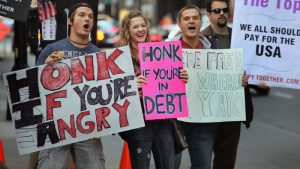
UPDATE: Two of the links in this post have been criticized for being misleading. I have changed them in order to clear up any confusion, and moved one of the original links to later in the piece for context. None of the text has been altered. Thanks to commenter anons for the feedback.
This was published with considerable feedback from affinis, Jasper, JuliaWilliams and lambert. My sincere thanks to them for their help.
A few weeks ago Occupy Oakland (OO) began to emphasize secrecy (or security culture) over transparency, which resulted in livestreamers being attacked as snitches or quasi-authorities. In addition, large group of transparency advocates have been ostracized as racists with little or no due process.
The attacks on transparency have become an ongoing effort; last week Kate Conger Tweeted her experience in running afoul of the secrecy police at OO. Interestingly, she is a freelancer who was more interested in the decision making process than whatever nefarious purpose the more conspiracy-minded saw in the shadows. And she also asked: “Explain to me why a movement founded on free speech principles doesn’t support freedom of press?” Which as far as I know has not been answered yet.
This week it has gone even further, led by the explosive charge that police used livestreaming video in the arrest of activists Nneka, Cincinnati and Teardrop – aka the Ice Cream Three.1 There has been a great deal of comment on the piece; the key excerpt:
According to defense lawyer Dan Siegel, it was the livestream footage that allowed OPD to target and arrest the Ice Cream Three at subsequent demonstrations over a week later: “There would be no case at all if people were not taking video and posting it publicly, and if the defendants had refused to speak with police once they were in custody.” Patti, Nneka’s mom, commented, “The really sad thing is that the footage came from Nneka’s best friend. She would never have wanted this!”
Keep in mind these are the thoughts of a defense attorney employed to present his client’s case in the best possible light. Maybe his allegations are true, but then again maybe not. The eagerness with which anti-transparency advocates have swallowed those comments whole is striking, even taking into account the natural human inclination to believe those things that bolster one’s worldview and more closely scrutinize those that don’t.2
One of the, ahem, benefits of shutting down efforts at openness is that those who are calling the shots can hide in a cloak of anonymity and make decisions from behind the scenes. Occupations that have shut down what began with a robust culture of openness have constructed a neatly self-contained universe – one that permits them to wield substantial authority but disclaim ownership of anything produced by it. (It also tends to create its own self-reinforcing structures.) Decision making done by a few, responsibility shared by all. See here for an analogous dynamic.
Those who want to constructively criticize that dynamic are then left grasping at straws: with no transparency, there is no way to know who in particular is driving these unhealthy developments.
If it seems that, say, facilitation has turned into a power center where much of the direction is set, but there is no way to see or read exactly what is going on, how does one even begin to offer a critique? Those who are happy as clams with this state of affairs can simply demand to know who in particular is the source of the problem. With no transparency into the process, this is unknowable from the outside. So those who wish to be insulated from accountability get a free ride. A nice arrangement, if you can manage it.
Perhaps not coincidentally, opacity tends to work well in conjunction with violence advocacy. A culture of repression is very congenial to chaotic notions of autonomy, “no snitching” orders3, and an apocalyptic mindset that insists if revolution does not happen immediately then all is lost.
It also seems supportive of a certain moral vacuousness that stridently denies any responsibility for violence on the grounds that the violence had already been completed by the real villains (e.g. “anarchists don’t fuck up health centers. Corporations and the government does”).4 Cries of snitching and sexism in support of an attack on a clinic that serves the community are a bit hard to take.
Opacity works well with a certain kind of wilfully naïve view of the process, too. Consensus doesn’t mean “everyone agrees” or even “most people agree.” It is very involved, and some in the Occupy power centers seem largely ignorant of it5. Look at the contrast between this from one of the folks on an InterOccupy listserv:
The early facilitators seemed to believe that OWS invented the consensus process. Many of us who had training and experience in consensus decision-making were dismayed from the beginning, because what we were witnessing was not consensus, but a faux consensus. Many didn’t return. I stayed to see if I could persuade the facilitation working group to adopt other modes, e.g. breaking up into groups during GAs, allowing for debates during GAs, making sure that substance was at least as important than process.
We have had a big problem of late in that insisting on being “leaderless” has left a vacuum that has been filled by tyrants in the group. Until the various dysfunctions are dealt with, we’re unlikely to make significant progress. A few of us have identified the dysfunction rooted in lack of nonviolence training, including true consensus decision-making. And add to that a lack of vision of how it all fits together in horizontalism self-governance on a broader scale.
And this by an anarchist in the OWS Direct Action Working Group
This is just such an elementary understanding of the anarchic nature of occupy’s functioning. It disregards autonomy entirely. You don’t need “the movement” to do something. When you do something that is movement. Movements are more time than group. If this is a time of a peoples liberation movement then things that happen now in that vein are pieces of that movement. If what you are doing appeals to folks you will get their buy in and if not you will be doing it on your own. Those are both ok, so long as you’re not speaking for people other than those present to consent to what’s being said on their behalf.
The reason consensus would be a burden is if you’re trying to force others into something they don’t want. Nothing about other’s non interest keeps you from doing something with those who choose to participate.
The ideas expressed in the second excerpt strike me as shockingly immature. You cannot just say, do your own thing and if others dig it a hundred flowers will bloom! Nor can you say that whatever any subset of Occupy does is by definition Occupy; some actions – most notably violence – will be seen as representative of the entire movement. For those who want a nonviolent mass movement, a violence advocate’s “when you do something that is movement” ends up being the negation of the movement.6
None of this is merely academic. Maintaining the charade that Occupy is leaderless, preventing any sort of visible decision making structure from emerging, not implementing any sort of review or sanction mechanism for those who refuse to adhere to an authentic consensus process: these all come at a terribly high cost, and nowhere was that more obvious last week than in the The Million Hoodie March. Elon James White wrote about his experience with an Occupy movement that at least partially attempted to co-opt a protest against the murder of Trayvon Martin. His report is consistent enough with others’ (Esther Choi’s, for example) that it cannot be dismissed as the griping of a malcontent.
Saying that those who tried to use the protest for their own ends are just a few bad apples is – in addition to being pretty stunningly unaware of the term’s unsavory recent history – a nonsensical response if your position is “when you do something that is movement.” In the kind of amorphous culture being created by those opposed to transparency, everyone does their own thing and therefore no one can be held responsible for anything. “That’s not the REAL Occupy” isn’t terribly persuasive under those conditions. However much logic it might have to those locked into that solipsistic world, the view of those like White and Choi who encounter it from the outside is overwhelmingly negative.
An Occupy movement that becomes increasingly insular and suspicious will thus alienate larger numbers of people. It will insist on its rightness and purity, oblivious to how it looks to those who haven’t been marinated in its exotic narrative. It will be unwieldy, with uncoordinated arms each pursuing its own agenda, sometimes in contradiction. It will turn off all but the true believers. The backlash against the actions of some at the Trayvon Martin protest is a good snapshot of where Occupy goes if it does not become more open and yes, more organized.
NOTES
1. Here’s a summary of the incident from the Oakland Police Department:
On February 22, 2012, at 6:00 p.m., the Oakland Police Department contacted a female victim after responding to a report of a robbery in the 4000 block of Piedmont Avenue. The victim told officers she had been walking down the street, across from the Wells Fargo bank, near a small group of Occupy Oakland protesters calling for a riot. The victim, who has been a resident of the area for over 20 years, suggested to the protesters not to riot in her neighborhood.
She was surrounded by three protestors and battered as they yelled vulgar epithets regarding their perception of her sexual orientation. Her wallet was taken during the crime. The victim broke away from the group, and called police who were able to arrest one suspect near the scene.
The Oakland Police Department prioritizes hate crimes for immediate investigation. A suspect who commits a hate crime aims not only to terrify or harm one individual, but to threaten and terrorize the entire actual or perceived group of people to which the victim may belong.
And a summary from a source more sympathetic to the defendants:
February 22nd was a day of arraignments for Occupy Oakland protesters at Wiley Manuel Courthouse in downtown Oakland. According to Nneka’s mother Patti, a group of approximately two dozen left the courthouse after the day’s proceedings for Fenton’s Creamery on Piedmont avenue and then convened a protest at the nearby Wells Fargo bank. An altercation took place later, around 5:45pm, in front of Dr. Comics & Mr. Games and was initiated by Stowers herself. In Stower’s testimony, she saw one Black woman, one Black man and one white man standing together on the sidewalk shouting the words “Let’s start a fucking riot!” As she passed them on her way to Piedmont Grocery she said, “I’ve lived in Piedmont for twenty years and I know you don’t belong here,” to which Nneka responded “that sounds pretty fucking racist to me,” and to which Teardrop replied “we need to talk about this.” In the confrontation that ensued, Stowers’ Obama pin was allegedly ripped from the outside flap of her purse. Then, she alleged, she saw Cincinnati’s forearm emerging from her purse. She did not actually see him remove her wallet.
(Back)
2. Note the assumption that live streaming being used to arrest violent insurgents is a bad thing. There are many possible objections to the arrest of activists in general. For instance: activists could just be removed and warehoused for extended periods without trial or in other ways denied due process; they could get shot through a judicial proceeding little more than a kangaroo court; put through a penal system that is heavy on retribution, light on rehabilitation, and that brands them as criminals long after they pay their debt to society.
Those are all perfectly legitimate points to raise. As a general proposition, though – and specifically without comment on the details of the Ice Cream Three case – I would regard the use of livestreaming to identify and arrest those engaged in violence as a ringing endorsement of live streaming, a vindication of its use and a victory for transparency.
Also: look at the contrast between this and a nonviolent mass movement like Otpor. They spared some energy to try to win over the police instead of taking a stance of unrelenting antagonism, took arrests in stride and included all walks of life (“Parents of the kids were informed, and we had a network of old ladies who called the police station continuously” etc.) Which approach is more flexible? More sustainable? Which is better able to subvert authority?
(Back)
3. The fact that conspiracies of silence are championed by gangs, the mafia, and those engaged in cover-ups tells you roughly where that tactic resides on the ethics spectrum. As David Graeber noted, one of the goals of Occupy should be to demonstrate an improvement on the existing culture and not merely to shuffle its privilege:
That’s why it’s key to have an effect that will genuinely benefit people’s lives. #Occupy certainly doesn’t contradict that revolutionary impulse, and helps move us in a direction towards greater freedom and autonomy, by which I mean freedom from the structures of both the state and capitalism. Now, to create broad alliances along those lines, you’d have to be very careful about your organizational and institutional structures. Because one of the things that is revolutionary about the #Occupy movement is that it’s trying to create prefigurative spaces in which we can experiment and create the kind of institutional structures that would exist in a society that’s free of the state and capitalism. We hope to use those to create a kind of crisis of legitimacy within existing institutions.
(Back)
4. Tina Dupuy makes the connection between transparency and nonviolence explicit:
A true nonviolent movement can have its plans known – the cops can know, the public can know, it can be on the livestream for everyone to see – because you can’t thwart civil disobedience by disclosure. Vandalism, property damage, graffiti, sabotage, throwing rocks and bottles at the police and petty criminal acts are not what the perpetrators want on UStream.
(Back)
5. For as important as consensus is, though, it shouldn’t be fetishized. It is a means, not an end, and if not monitored carefully it can obstruct the achievement of the ends it is being used to further.
(Back)
6. For just one example of how violence is inimical to a mass movement, look at how Canadians reacted to the use of it during protests. When the public views you as a terrorist maybe you aren’t some romanticized revolutionary vanguard as much as a common criminal.
(Back)








